| |
 |
 |
 |
|
 |
 |
 |
 |
 |

|
 |
 |
|
|
|
 |
New Molecular Self-Assembly Technique May Mimic How Cells Assemble Themselves
|
 |
| |
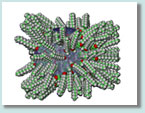 Researchers from the University of Pennsylvania and the University of Sheffield report in the Feb. 21 issue of Science that they have created tree-like molecules that assemble themselves into precisely structured building blocks of a quarter-million atoms. Such building blocks may be precursors to designing nanostructures for molecular electronics or photonics materials, which "steer" light in the same way computer chips steer electrons. Virgil Percec, the P. Roy Vagelos Chair and Professor of Chemistry at the University of Pennsylvania, and his colleagues also provide chemists with pointers for designing variations of the tree-like molecules to form even larger-scale structures. The work is funded by the Engineering and Physical Sciences Research Council in the United Kingdom and the U.S. National Science Foundation. Researchers from the University of Pennsylvania and the University of Sheffield report in the Feb. 21 issue of Science that they have created tree-like molecules that assemble themselves into precisely structured building blocks of a quarter-million atoms. Such building blocks may be precursors to designing nanostructures for molecular electronics or photonics materials, which "steer" light in the same way computer chips steer electrons. Virgil Percec, the P. Roy Vagelos Chair and Professor of Chemistry at the University of Pennsylvania, and his colleagues also provide chemists with pointers for designing variations of the tree-like molecules to form even larger-scale structures. The work is funded by the Engineering and Physical Sciences Research Council in the United Kingdom and the U.S. National Science Foundation.
Image Credit: Virgil Percec, University of Pennsylvania
Read
the full story . ... Posted
2/24/03
|
 |
Researchers Will No Longer Be "Snowed" in Predicting Future Avalanches; Study of variations in snow stability over geography and time are key, scientists say
|
 |
| |
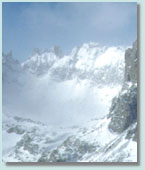 The recent deaths of 14 Canadian skiers in two separate snow avalanches in British Columbia have increased attention on safety issues, but some U.S. scientists are turning their focus elsewhere - to studying the properties of snow stability that could lead to more accurate means of predicting avalanche events. Montana State University professor of geography Kathy Hansen has received a $160,000 National Science Foundation grant to do a comprehensive study of snow stability over space and time. Revealing some of the true properties and behaviors of snow could lead to better predictions of potential avalanches in the western United States as well as in the alpine regions of the world, she contends. The recent deaths of 14 Canadian skiers in two separate snow avalanches in British Columbia have increased attention on safety issues, but some U.S. scientists are turning their focus elsewhere - to studying the properties of snow stability that could lead to more accurate means of predicting avalanche events. Montana State University professor of geography Kathy Hansen has received a $160,000 National Science Foundation grant to do a comprehensive study of snow stability over space and time. Revealing some of the true properties and behaviors of snow could lead to better predictions of potential avalanches in the western United States as well as in the alpine regions of the world, she contends.
Photo courtesy: Dr. John Marr
Read
the full story . ... Posted
2/20/03
|
 |
NSF, Science Journal Announce Science Visualization Contest
|
 |
| |
 The
National Science Foundation and the journal Science are now
accepting entries for the inaugural 2003
Science and Engineering Visualization Challenge.
This new international contest will recognize
outstanding achievement by scientists, engineers,
and visual information practitioners in the
use of visual media to promote understanding
of research results. Winning selections
will be featured in a special section of Science's
Sept. 12 edition and winners will receive
an expense-paid trip to the foundation for
its "Art of Science Project" exhibit
and accompanying lecture. The
National Science Foundation and the journal Science are now
accepting entries for the inaugural 2003
Science and Engineering Visualization Challenge.
This new international contest will recognize
outstanding achievement by scientists, engineers,
and visual information practitioners in the
use of visual media to promote understanding
of research results. Winning selections
will be featured in a special section of Science's
Sept. 12 edition and winners will receive
an expense-paid trip to the foundation for
its "Art of Science Project" exhibit
and accompanying lecture.
Read
the full story . ... Posted
2/11/03
|
 |
NSF Webcast Features Researcher William R. Hammer Talking about Jurassic Dinosaurs from Antarctica and NSF Representative in Antarctia David Bresnahan Fielding Questions about Antarctica Today
|
 |
| |
 The National Science Foundation presented a live webcast on Feb. 26 featuring a lecture on "Dinosaurs on Ice: Jurassic Dinosaurs from Antarctica" by William R. Hammer. During the 1990-91 Antarctic field season, Hammer, an NSF-funded researcher, discovered the remains of Cryolophosaurus ellioti, or "frozen crested reptile." Hammer's paper describing the extinct creature was published in the journal Science in 1994. The webcast also featured David Bresnahan, NSF's Representative in Antarctica, who participated via a telecommunications link from McMurdo Station, NSF's science and logistics hub in Antarctica. Bresnahan answered questions posed by schoolchildren who braved the snow in Baltimore to take part in the event at the Maryland Science Center's IMAX Theater. Wednesday's webcast coincides with an exhibit and symposium, "Revelations in the Ice - Shackleton’s Legacy: Antarctica Today," at the center. The archived webcast will be available soon. The National Science Foundation presented a live webcast on Feb. 26 featuring a lecture on "Dinosaurs on Ice: Jurassic Dinosaurs from Antarctica" by William R. Hammer. During the 1990-91 Antarctic field season, Hammer, an NSF-funded researcher, discovered the remains of Cryolophosaurus ellioti, or "frozen crested reptile." Hammer's paper describing the extinct creature was published in the journal Science in 1994. The webcast also featured David Bresnahan, NSF's Representative in Antarctica, who participated via a telecommunications link from McMurdo Station, NSF's science and logistics hub in Antarctica. Bresnahan answered questions posed by schoolchildren who braved the snow in Baltimore to take part in the event at the Maryland Science Center's IMAX Theater. Wednesday's webcast coincides with an exhibit and symposium, "Revelations in the Ice - Shackleton’s Legacy: Antarctica Today," at the center. The archived webcast will be available soon.
More information . ... Posted
2/26/03
|
|
 |
Nearly-Naked Stars Boost the Pulse of Asteroseismology
|
 |
| |
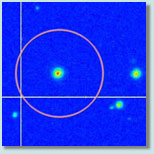 What goes on inside the heart of a star? Astronomers have been developing theories about stars' inner workings for decades, but evidence to confirm the details of those theories has been sparse. In research supported by NSF, University of Arizona astronomer Elizabeth Green and colleagues have found a new subset of "nearly-naked" stars that dim and brighten due to pulses in their cores. The stars, which may help unlock secrets of advanced stages of stellar evolution, are described in the January 20 Astrophysical Journal Letters. What goes on inside the heart of a star? Astronomers have been developing theories about stars' inner workings for decades, but evidence to confirm the details of those theories has been sparse. In research supported by NSF, University of Arizona astronomer Elizabeth Green and colleagues have found a new subset of "nearly-naked" stars that dim and brighten due to pulses in their cores. The stars, which may help unlock secrets of advanced stages of stellar evolution, are described in the January 20 Astrophysical Journal Letters.
Image courtesy: Elizabeth Green of Steward Observatory at the University of Arizona and NSF.
Read
the full story . ... Posted
2/11/03
|
|
 |
NSF Releases New Report from Its Advisory Committee for Cyberinfrastructure
|
 |
| |
 The critical needs of science and rapid progress in information technology are converging to provide a unique opportunity to create and apply a sustained cyberinfrastructure that will "radically empower" scientific and engineering research and allied education, according to the National Science Foundation's Advisory Committee for Cyberinfrastructure. The committee details its recommendations in a report, released on Feb. 3, entitled Revolutionizing Science and Engineering through Cyberinfrastructure. Cyberinfrastructure is "essential, not optional, to the aspirations of research communities." For scientists and engineers, the report states, cyberinfrastructure has the potential to "revolutionize what they can do, how they do it, and who participates." The critical needs of science and rapid progress in information technology are converging to provide a unique opportunity to create and apply a sustained cyberinfrastructure that will "radically empower" scientific and engineering research and allied education, according to the National Science Foundation's Advisory Committee for Cyberinfrastructure. The committee details its recommendations in a report, released on Feb. 3, entitled Revolutionizing Science and Engineering through Cyberinfrastructure. Cyberinfrastructure is "essential, not optional, to the aspirations of research communities." For scientists and engineers, the report states, cyberinfrastructure has the potential to "revolutionize what they can do, how they do it, and who participates."
Read
the full story . ... Posted
2/7/03
|
 |
NSF Joins
the NASA Family in Sorrow |
 |
| |
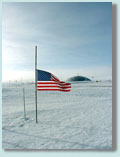 NSF
joins the NASA family in sorrow for the
loss of seven brave explorers and their
ship. Over the centuries, the quest for
knowledge has so often involved high risk.
But the passion to explore has driven
humankind to search the depths of the
sea, the breadth of continents, and in
the last half century, the far reaches
of space. These missions to know and understand
are the very definition of our humanness.
Along with all Americans, we take time
this week to contemplate the gift of courage
of the seven astronauts and to appreciate
the fragile thread we call life. - NSF
Director Rita Colwell NSF
joins the NASA family in sorrow for the
loss of seven brave explorers and their
ship. Over the centuries, the quest for
knowledge has so often involved high risk.
But the passion to explore has driven
humankind to search the depths of the
sea, the breadth of continents, and in
the last half century, the far reaches
of space. These missions to know and understand
are the very definition of our humanness.
Along with all Americans, we take time
this week to contemplate the gift of courage
of the seven astronauts and to appreciate
the fragile thread we call life. - NSF
Director Rita Colwell
Photo: Jerry Marty/NSF
... Posted 2/3/03
|
 |
NSF
Seeks 2004 Budget of $5.48 Billion; Increase
will address priorities of "immediate
national importance" |
 |
| |
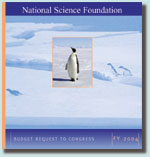 The
National Science Foundation (NSF) has
sent to Congress a fiscal 2004 budget
request of $5.48 billion -- an investment
representing what the agency believes
will "sustain and build U.S. global leadership
in science, engineering and technology,
and help the United States address priorities
of immediate national importance." The
increase sought in 2004 over NSF's 2003
request would amount to about 9 percent.
Although NSF's 2004 request calls for
a 60 percent hike in major research equipment
and facilities, the overall 8.5 percent
increase sought for core research and
related activities (people, ideas and
tools) is at the heart of NSF's overall
budget priorities for the coming year. The
National Science Foundation (NSF) has
sent to Congress a fiscal 2004 budget
request of $5.48 billion -- an investment
representing what the agency believes
will "sustain and build U.S. global leadership
in science, engineering and technology,
and help the United States address priorities
of immediate national importance." The
increase sought in 2004 over NSF's 2003
request would amount to about 9 percent.
Although NSF's 2004 request calls for
a 60 percent hike in major research equipment
and facilities, the overall 8.5 percent
increase sought for core research and
related activities (people, ideas and
tools) is at the heart of NSF's overall
budget priorities for the coming year.
Read
the full story . ... posted
2/3/03
|
 Top
of Page Top
of Page
|
|
|
 |
 |
 |
 |
 |
 |
 |
 |
|
 |
 |
 |
|
|

